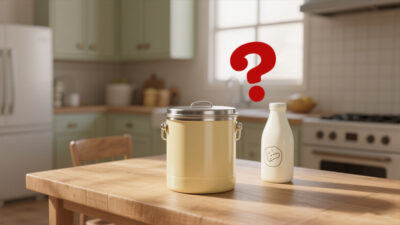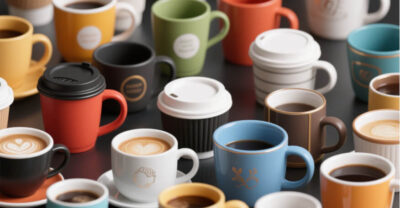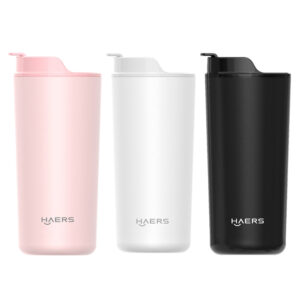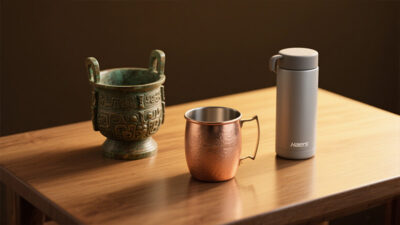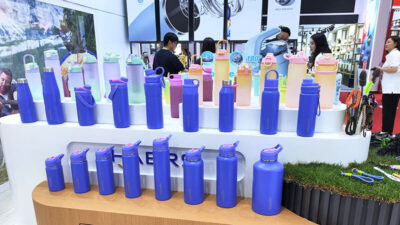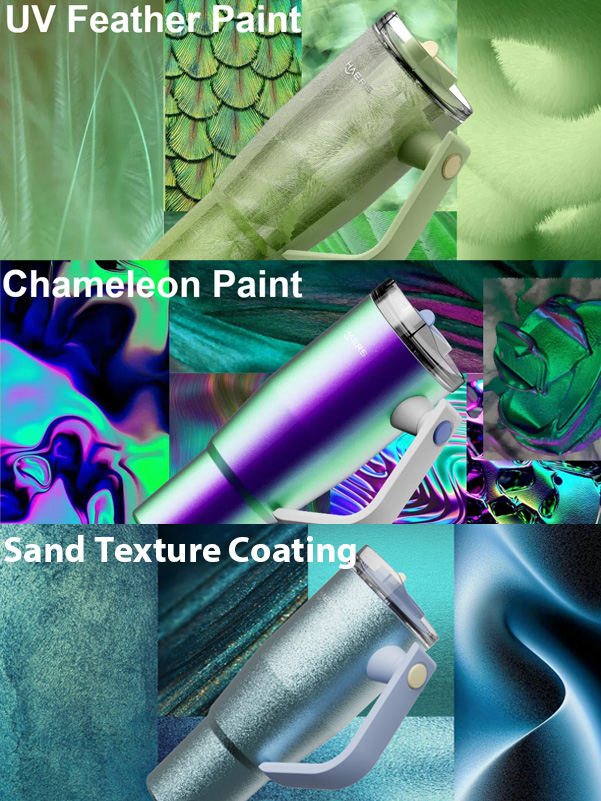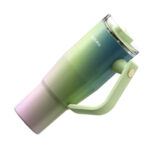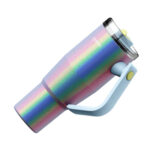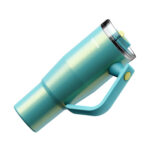Do Insulated Bottles Have to Be Made of Stainless Steel?
Insulated bottles have become a go-to item for staying hydrated with drinks at just the right temperature. Whether it’s hot coffee in the morning or chilled water on a hike, people rely on them throughout the day.
For years, stainless steel was the default material for insulated bottles. It was durable, widely available, and relatively affordable. But early designs had their flaws—many were bulky, had a metallic taste, and didn’t always deliver on heat retention. These issues led to a wave of innovation across the industry.
Today, things look very different. With advancements in vacuum insulation technology, modern bottles can keep drinks hot or cold for much longer without adding weight or bulk. Material options have also expanded beyond basic 304 stainless steel. You’ll now find bottles made with 316 medical-grade stainless steel for added corrosion resistance, ceramic liners for a neutral taste, and even titanium for those who want something lightweight yet premium.
Table of Contents
ToggleHow Do Insulated Bottles Keep Drinks Hot or Cold?
The secret behind an insulated bottle’s temperature retention lies in its smart design that blocks heat transfer in three ways: conduction, convection, and radiation. Most insulated bottles feature a double-wall construction with a vacuum between the layers, and add extra layers like copper coating or aluminum foil. Since this vacuum contains almost no air, it greatly reduces heat transfer through conduction and convection—without air molecules to collide or circulate, heat simply can’t move through.

Many bottles take it a step further by adding a reflective coating on the inner wall’s outer surface. This mirror-like layer bounces radiant heat back inside, creating a “vacuum plus reflection” system that forms a powerful thermal barrier.
Beyond the vacuum, the materials and sealing design also play key roles. Metals like stainless steel conduct heat well, but when paired with the vacuum layer and double walls, they actually help block heat loss. Tight seals and well-designed lids prevent heat from escaping through the bottle opening.
Put simply, an insulated bottle acts like a thermal shield for your drink, using multiple layers of protection to minimize heat exchange and keep your beverage at the ideal temperature for hours.
What Materials Are Used for Insulated Bottles?
Insulated bottles come in a variety of materials, each with unique insulation properties and practical benefits.
Stainless Steel
Stainless steel is the most common material for insulated bottles today. The inner layers typically use food-grade 304 or 316 stainless steel, which effectively blocks external temperatures without affecting the taste or safety of the drink. Stainless steel bottles are well-suited for storing room temperature water, hot water, tea, and more. Their key advantages include excellent heat retention, durability, and health safety. The materials do not release harmful substances, and the bottles resist dents, scratches, and corrosion, making them long-lasting.
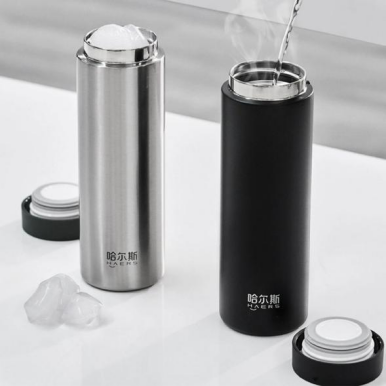
Glass
Glass-insulated bottles are popular for their pure taste and non-reactive surface. Most feature a double-wall vacuum design with a sealed hollow space between the inner liner and outer shell. However, glass does not insulate as well as stainless steel and is more fragile, which may raise safety concerns during daily use.
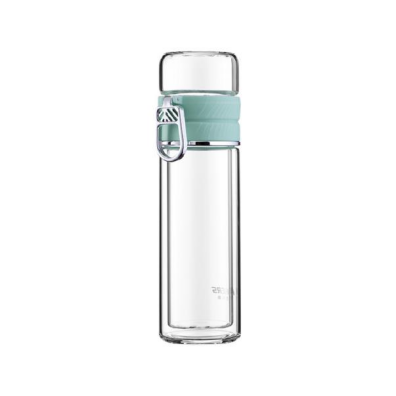
Ceramic
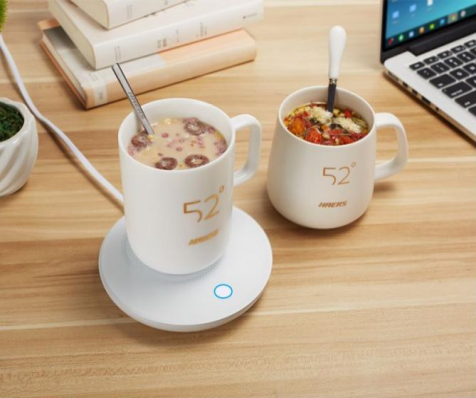
Ceramic insulated bottles combine traditional ceramic materials with modern insulation techniques. They offer strong heat retention and are environmentally friendly without harmful emissions. Ceramic bottles are easy to clean and have a relatively long lifespan. On the downside, they tend to be heavy, less portable, and more prone to breaking if dropped, so they require careful handling.
Plastic
Plastic insulated bottles are lightweight and resistant to damage but cannot achieve true vacuum insulation. Most plastic bottles provide only basic heat insulation, meaning their heat retention is much weaker compared to stainless steel or ceramic bottles. Additionally, long-term use may pose risks of chemical leaching, raising health concerns.
Titanium
Titanium is known as a “premium metal” in the food industry due to its non-toxic nature, high strength, and low weight—about 50% lighter than stainless steel. Titanium bottles offer excellent durability, corrosion resistance, and antibacterial properties. They maintain stability under high temperatures and do not rust or impart odors. These features make titanium bottles lightweight, portable, and easy to maintain.
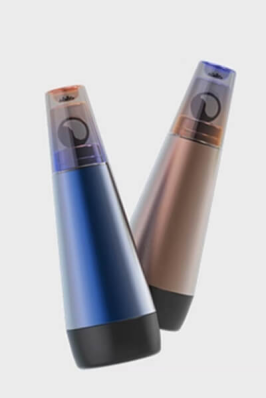
Other Materials
Other materials used include silicone and various metal liners. Silicone bottles are soft, heat-resistant, and easy to clean, making them popular, especially as baby-friendly options. Metal-lined bottles offer good insulation but may affect water taste and require careful cleaning to maintain quality.

What Should Retailers Consider When Choosing Insulated Bottle Materials?
Selecting the right material for insulated bottles is a balancing act between cost, performance, user needs, and manufacturing feasibility. For retailers and brand owners, understanding these factors helps position products correctly in the market and meet customer expectations.
1. Cost Positioning
Material choice directly affects product pricing and market positioning:
- Entry-level products often use plastic (like Tritan) or standard 304 stainless steel. Tritan is lightweight, easy to mold, and ideal for mass-market, low-cost models. 304 stainless steel offers better durability and insulation, making it a mainstream choice.
- Mid-to-high-end products may feature 316 stainless steel or borosilicate glass. 316 is more corrosion-resistant and appeals to health-conscious consumers. Borosilicate glass is odorless and clean, ideal for tea and coffee drinkers who value purity.
- Premium products lean toward titanium or ceramic. Titanium is ultralight, corrosion-resistant, and well-suited for outdoor enthusiasts. Ceramic offers a refined aesthetic and is often chosen for gift sets or collector’s items. Both come with higher production costs.
2. Usage Scenarios
The right material depends on the intended use case:

- Outdoor & Sports: Lightweight and durable materials are a must. Plastic bottles are impact-resistant and easy to carry. Titanium bottles are perfect for extreme conditions like hiking or mountaineering due to their strength and corrosion resistance.
- Office & Daily Commute: Heat retention and ease of cleaning matter most. Stainless steel bottles are practical for busy professionals, while glass-lined options add a premium, desk-friendly touch and are easy to clean after tea or coffee.
- Parenting & Wellness: Safety is key. Tritan, ceramic, and glass are preferred for their non-metallic interiors, which reduce the risk of chemical interaction—ideal for baby formula, herbal drinks, or sensitive users.
- Gifting & Collectibles: Visual appeal and exclusivity are important. Ceramic and titanium, with custom printing or engraving, offer the uniqueness and quality perception needed in the giftware sector.
3. Durability
Different materials offer varying levels of long-term performance:
- Impact & scratch resistance: Plastic bottles resist drops but degrade over time. Stainless steel is more rugged but may show surface scratches. Ceramic and glass require protective outer layers to reduce breakage risks. Titanium offers high strength and long-term reliability.
- Corrosion & stain resistance: 316 stainless steel performs well with acidic drinks like juice or soda. Ceramic and glass surfaces are smooth and easy to clean. Plastic may deteriorate with extended use, especially when exposed to acidic content.
- Lifespan: Vacuum insulation in stainless steel and titanium bottles can last several years. In contrast, plastic and glass may require more frequent replacement due to wear or damage.
4. Manufacturing Feasibility
Retailers should also consider production logistics when selecting materials:
- Mass production: Stainless steel and plastic are ideal for high-volume orders. Both support streamlined manufacturing with high automation, making them cost-effective for large-scale distribution.
- Small-batch customization: Ceramic and titanium are better for limited runs and bespoke designs. Ceramic involves hand-finishing and kiln firing, while titanium requires precision processing—both increase production time but allow for premium, custom offerings.
- Technical complexity: Stainless steel and plastic are mature materials with high yield rates. Ceramic poses risks of cracking during firing, while titanium requires advanced equipment and skilled labor. Manufacturing risks should be assessed early to avoid budget overruns.
5. Compliance and Sustainability
- Safety standards: Food-contact materials must meet strict regulations such as China’s GB 4806, the EU’s LFGB, or the US FDA. Retailers should ensure selected materials comply with migration limits for heavy metals (in stainless steel) or BPA (in plastics).
- Eco-friendliness: Sustainability is a growing concern. Plastic bottles are recyclable; stainless steel and titanium are long-lasting and reduce waste. Ceramic and glass, while less recyclable, can be produced using low-emission techniques to minimize environmental impact.
Choosing the right insulated bottle material isn’t just about performance specs—it’s about matching the right product to the right customer, at the right price point, with the right supply chain behind it. Whether you’re aiming to launch a high-volume everyday product, a specialized bottle for health-conscious consumers, or a premium design for gifting, the material you choose will shape not only the product experience but your brand perception in the market.
At Haers, we’ve been helping retailers and brand owners navigate these choices for over 20 years, offering a full range of bulk insulated bottles in stainless steel, glass and titanium,with custom solutions that fit your market goals and budget.
Ready to find the perfect material for your next product line?
Get in touch with our team today to explore samples, discuss customization options, or start a quote.


